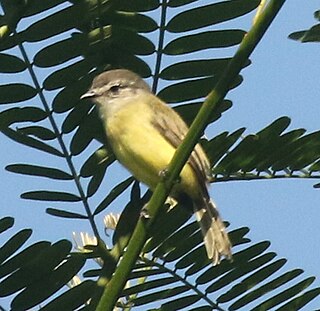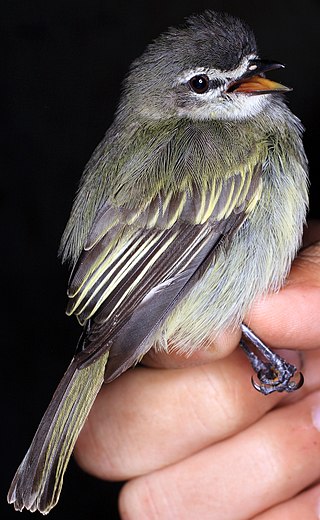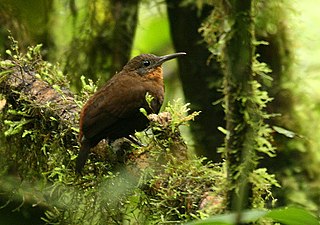
The ochre-bellied flycatcher is a small bird of the tyrant flycatcher family. It is found in Mexico, every Central American country, Trinidad and Tobago, and every mainland South American country except Argentina, Chile, Paraguay, and Uruguay.

The short-tailed antthrush is a species of bird in the family Formicariidae. It is found in every mainland South American country except Chile, French Guiana, and Uruguay.

The great elaenia is a species of bird in subfamily Elaeniinae of family Tyrannidae, the tyrant flycatchers. It is found in Brazil and Venezuela.

The Roraiman antwren is an insectivorous bird in subfamily Thamnophilinae of family Thamnophilidae, the "typical antbirds". It is found in Brazil, Guyana, and Venezuela.

The white-throated tyrannulet is a species of bird in subfamily Elaeniinae of family Tyrannidae, the tyrant flycatchers. It is found in Argentina, Bolivia, Brazil, Colombia, Ecuador, Peru, and Venezuela.

McConnell's flycatcher is a species of bird in the tyrant flycatcher family Tyrannidae. It is found in Bolivia, Brazil, French Guiana, Guyana, Peru, Suriname, and Venezuela.

Mionectes is a genus of birds in the tyrant flycatcher family Tyrannidae.

The olive-striped flycatcher is a species of bird in the family Tyrannidae, the tyrant flycatchers. It is found in Bolivia, Colombia, Ecuador, Panama, Peru, Trinidad, and Venezuela.

The sooty-headed tyrannulet is a species of bird in subfamily Elaeniinae of family Tyrannidae, the tyrant flycatchers. It is found in Brazil, Colombia, Ecuador, French Guiana, Guyana, Panama, Peru, Suriname, and Venezuela.

Chapman's bristle tyrant, also known as Chapman's tyrannulet, is a species of passerine bird in the family Tyrannidae, the tyrant flycatchers. It is found in Brazil, Guyana, and Venezuela.

The Roraiman barbtail is a species of bird in the Furnariinae subfamily of the ovenbird family Furnariidae. It is found in Brazil, Guyana, and Venezuela.

McConnell's spinetail is a species of bird in the Furnariinae subfamily of the ovenbird family Furnariidae. It is found in Brazil, French Guiana, Guyana, Suriname, and Venezuela.

The Venezuelan tyrannulet is a species of passerine bird in the family Tyrannidae, the tyrant flycatchers. It is endemic to Venezuela.

The masked trogon is a species of bird in the family Trogonidae. It is fairly common in humid highland forests in South America, mainly the Andes and tepuis.

The foothill screech owl is a species of owl in the family Strigidae. It is found in Bolivia, Brazil, Colombia, Ecuador, Guyana, Suriname, and Venezuela.

The white-fronted tyrannulet is a species of bird in subfamily Elaeniinae of family Tyrannidae, the tyrant flycatchers. It is found in Bolivia, Colombia, Costa Rica, Ecuador, Panama, Peru, and Venezuela.

The spectacled tyrannulet, also known as the specious tyrannulet, mountain tyrannulet, and Venezuelan tyrannulet, is a small passerine bird in the family Tyrannidae, the tyrant flycatchers. It is found in Colombia and Venezuela.
Mercedes Suarez Foster is an American zoologist who researched the evolution of lek behavior in birds, bird-plant interactions, and male-male cooperation in reproduction. She is very active in conservation efforts, including training workshops, being a Scientific Advisor for the National Bio-inventory Program of Paraguay, as a Founding Director of the American Bird Conservancy, and as a Founder and Co-coordinator of the Latin American Library Enhancement Program. She is also the Director and Editor of a program to publish handbooks giving "standard methods for measuring and monitoring the biodiversity of different groups of organisms".

The tepui elaenia is a species of bird in subfamily Elaeniinae of family Tyrannidae, the tyrant flycatchers. It is found in Brazil, Guyana, and Venezuela.

The dusky leaftosser or South American leaftosser is a bird in subfamily Sclerurinae, the leaftossers and miners, of the ovenbird family Furnariidae. It is found in Bolivia, Brazil, Colombia, Ecuador, French Giana, Guyana, Panama, Peru, Suriname, and Venezuela.





















